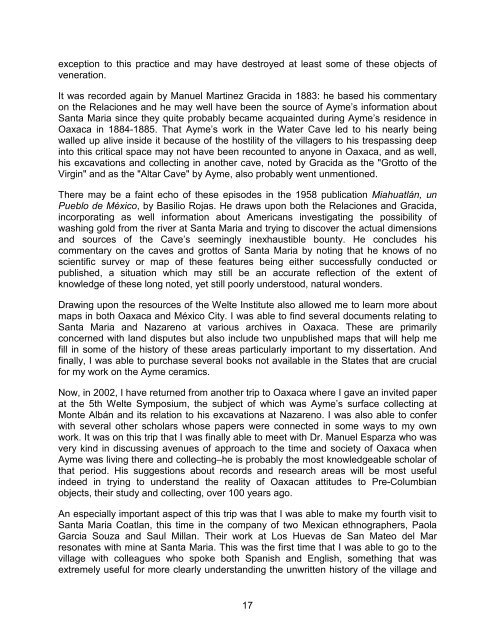Tracing Louis H. Ayme's Explorations in Oaxaca, México ... - Famsi
Tracing Louis H. Ayme's Explorations in Oaxaca, México ... - Famsi
Tracing Louis H. Ayme's Explorations in Oaxaca, México ... - Famsi
You also want an ePaper? Increase the reach of your titles
YUMPU automatically turns print PDFs into web optimized ePapers that Google loves.
exception to this practice and may have destroyed at least some of these objects of<br />
veneration.<br />
It was recorded aga<strong>in</strong> by Manuel Mart<strong>in</strong>ez Gracida <strong>in</strong> 1883: he based his commentary<br />
on the Relaciones and he may well have been the source of Ayme’s <strong>in</strong>formation about<br />
Santa Maria s<strong>in</strong>ce they quite probably became acqua<strong>in</strong>ted dur<strong>in</strong>g Ayme’s residence <strong>in</strong><br />
<strong>Oaxaca</strong> <strong>in</strong> 1884-1885. That Ayme’s work <strong>in</strong> the Water Cave led to his nearly be<strong>in</strong>g<br />
walled up alive <strong>in</strong>side it because of the hostility of the villagers to his trespass<strong>in</strong>g deep<br />
<strong>in</strong>to this critical space may not have been recounted to anyone <strong>in</strong> <strong>Oaxaca</strong>, and as well,<br />
his excavations and collect<strong>in</strong>g <strong>in</strong> another cave, noted by Gracida as the "Grotto of the<br />
Virg<strong>in</strong>" and as the "Altar Cave" by Ayme, also probably went unmentioned.<br />
There may be a fa<strong>in</strong>t echo of these episodes <strong>in</strong> the 1958 publication Miahuatlán, un<br />
Pueblo de <strong>México</strong>, by Basilio Rojas. He draws upon both the Relaciones and Gracida,<br />
<strong>in</strong>corporat<strong>in</strong>g as well <strong>in</strong>formation about Americans <strong>in</strong>vestigat<strong>in</strong>g the possibility of<br />
wash<strong>in</strong>g gold from the river at Santa Maria and try<strong>in</strong>g to discover the actual dimensions<br />
and sources of the Cave’s seem<strong>in</strong>gly <strong>in</strong>exhaustible bounty. He concludes his<br />
commentary on the caves and grottos of Santa Maria by not<strong>in</strong>g that he knows of no<br />
scientific survey or map of these features be<strong>in</strong>g either successfully conducted or<br />
published, a situation which may still be an accurate reflection of the extent of<br />
knowledge of these long noted, yet still poorly understood, natural wonders.<br />
Draw<strong>in</strong>g upon the resources of the Welte Institute also allowed me to learn more about<br />
maps <strong>in</strong> both <strong>Oaxaca</strong> and <strong>México</strong> City. I was able to f<strong>in</strong>d several documents relat<strong>in</strong>g to<br />
Santa Maria and Nazareno at various archives <strong>in</strong> <strong>Oaxaca</strong>. These are primarily<br />
concerned with land disputes but also <strong>in</strong>clude two unpublished maps that will help me<br />
fill <strong>in</strong> some of the history of these areas particularly important to my dissertation. And<br />
f<strong>in</strong>ally, I was able to purchase several books not available <strong>in</strong> the States that are crucial<br />
for my work on the Ayme ceramics.<br />
Now, <strong>in</strong> 2002, I have returned from another trip to <strong>Oaxaca</strong> where I gave an <strong>in</strong>vited paper<br />
at the 5th Welte Symposium, the subject of which was Ayme’s surface collect<strong>in</strong>g at<br />
Monte Albán and its relation to his excavations at Nazareno. I was also able to confer<br />
with several other scholars whose papers were connected <strong>in</strong> some ways to my own<br />
work. It was on this trip that I was f<strong>in</strong>ally able to meet with Dr. Manuel Esparza who was<br />
very k<strong>in</strong>d <strong>in</strong> discuss<strong>in</strong>g avenues of approach to the time and society of <strong>Oaxaca</strong> when<br />
Ayme was liv<strong>in</strong>g there and collect<strong>in</strong>g–he is probably the most knowledgeable scholar of<br />
that period. His suggestions about records and research areas will be most useful<br />
<strong>in</strong>deed <strong>in</strong> try<strong>in</strong>g to understand the reality of <strong>Oaxaca</strong>n attitudes to Pre-Columbian<br />
objects, their study and collect<strong>in</strong>g, over 100 years ago.<br />
An especially important aspect of this trip was that I was able to make my fourth visit to<br />
Santa Maria Coatlan, this time <strong>in</strong> the company of two Mexican ethnographers, Paola<br />
Garcia Souza and Saul Millan. Their work at Los Huevas de San Mateo del Mar<br />
resonates with m<strong>in</strong>e at Santa Maria. This was the first time that I was able to go to the<br />
village with colleagues who spoke both Spanish and English, someth<strong>in</strong>g that was<br />
extremely useful for more clearly understand<strong>in</strong>g the unwritten history of the village and<br />
17
















